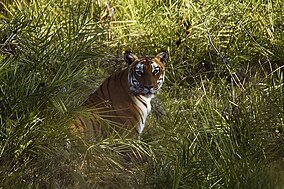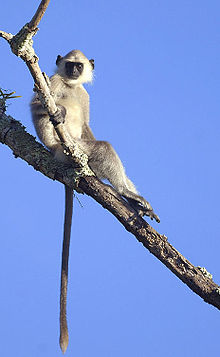Bandipur National Park
| Bandipur National park | |
|---|---|
| Bandipur National Park | |
 Bengal tiger in Bandipur | |
 | |
| Location | Chamarajanagar district, Karnataka, India |
| Nearest city | Chamarajanagar 50 km, Mysore 80 kilometers (50 mi) |
| Coordinates | 11°39′42″N 76°37′38″E / 11.66167°N 76.62722°ECoordinates: 11°39′42″N 76°37′38″E / 11.66167°N 76.62722°E |
| Established | 1974 |
| Governing body | Ministry of Environment and Forests, Karnataka Forest Department |
| bandipurtigerreserve | |
Bandipur National Park, established in 1974 as a tiger reserve under Project Tiger, is a national park located in the Indian state of Karnataka, which is the state with the second highest tiger population in India. It is one of the premiere tiger reserves in India alongside Nagarhole National Park, Mudumalai National Park and Wayanad National Park. It was once a private hunting reserve for the Maharaja of the Kingdom of Mysore but has now been upgraded to Bandipur Tiger Reserve.[1] Bandipur is known for its wildlife and has many types of biomes, but dry deciduous forest is dominant.
The park spans an area of 874 square kilometers (337 sq mi), protecting several species of India's endangered wildlife. Together with the adjoining Nagarhole National Park (643 km2 (248 sq mi)), Mudumalai National Park (320 km2 (120 sq mi)) and Wayanad Wildlife Sanctuary (344 km2 (133 sq mi)), it is part of the Nilgiri Biosphere Reserve totaling 2,183 km2 (843 sq mi) making it the largest protected area in southern India and largest habitat of wild elephants in south Asia.
Bandipur is located in Gundlupet taluk of Chamarajanagar district. It is about 80 kilometers (50 mi) from the city of Mysore on the route to a major tourist destination of Ooty.[2] As a result, Bandipur sees many tourists; many wildlife fatalities caused by speeding vehicles are reported each year.[3] There is a ban on traffic from 9 pm to 6 am of dusk to dawn to help bring down the death rate of wildlife.[4]
History[]
The Maharaja of the Kingdom of Mysore created a sanctuary of 90 km2 (35 sq mi) in 1931 and named it the Venugopala Wildlife Park. The Bandipur Tiger Reserve was established under Project Tiger in 1973 by adding nearly 800 km2 (310 sq mi) to the Venugopala Wildlife park.[5]
Geography[]

Bandipur National Park is located between 75° 12’ 17" E to 76° 51’ 32" E and 11° 35’ 34" N to 11° 57’ 02" N where the Deccan Plateau meets the Western Ghats, and the altitude of the park ranges from 680 meters (2,230 ft) to 1,454 meters (4,770 ft). As a result, the park has a variety of biomes including dry deciduous forests, moist deciduous forests and shrublands. The wide range of habitats help support a diverse range of organisms. The park is flanked by the Kabini river in the north and the Moyar river in the south. The Nugu river runs through the park. The highest point in the park is on a hill called Himavad Gopalaswamy Betta, where there is a Hindu temple at the summit. Bandipur has typical tropical climate with distinct wet and dry seasons. The dry and hot period usually begins in early March and can last till the arrival of the monsoon rains in June.
Biology and ecology[]
Bandipur National Park helps protect several species of India's endangered wildlife and also provides refuge to other threatened and vulnerable species of flora and fauna.
Flora[]

Bandipur supports a wide range of timber trees including: teak (Tectona grandis), rosewood (Dalbergia latifolia), sandalwood (Santalum album V), Indian-laurel (Terminalia tomentosa), Indian kino tree (Pterocarpus marsupium), giant clumping bamboo (Dendrocalamus strictus), clumping bamboo (Bambusa arundinacea) and Grewia tiliaefolia.
There are also several notable flowering and fruiting trees and shrubs including: kadam tree (Adina cordifolia), Indian gooseberry (Emblica officinalis), crape-myrtle (Lagerstroemia lanceolata), axlewood (Anogeissus latifolia), black myrobalan (Terminalia chebula), Schleichera trijuga, Odina wodiar, flame of the forest (Butea monosperma), golden shower tree (Cassia fistula), satinwood (Chloroxylon swietenia), black cutch (Acacia catechu), Shorea talura (E), indigoberry (Randia uliginosa).
Fauna[]
Bandipur supports a good population of endangered and vulnerable species like Indian elephants, gaurs, tigers, sloth bears, muggers, Indian rock pythons, four-horned antelopes, jackals and dholes.
Mammals[]

The commonly seen mammals along the public access roads in the park include chital, gray langurs, Indian giant squirrels and elephants. A list of medium to large-sized mammals in the park is given in the following census table published in 1997:
| species | 1991 | 1993 | 1995 | 1997 |
|---|---|---|---|---|
| Bengal Tiger | 58 | 66 | 74 | 75 |
| Indian Leopard | 51 | 81 | 86 | 88 |
| Indian elephant | 1107 | 2214 | 2214 | 3471 |
| Gaur | 1097 | 1373 | 1373 | 2427 |
| Dhole | 148 | 181 | 181 | N/A |
| Chital | 3333 | 5858 | 5858 | 8204 |
| Sambar | 706 | 1196 | 1196 | 2386 |
| Sloth bear | 51 | 66 | 66 | N/A |
| Four-horned antelope | 14 | N/A | N/A | N/A |
| Gray langur | 1468 | 1751 | 1751 | 1851 |
| Wild boar | 148 | 181 | 181 | N/A |
| Muntjac | 72 | 131 | 131 | N/A |
Birds[]
Peafowl are among the most commonly seen birds in Bandipur along with grey junglefowl, crows and drongos. Bandipur is home to over 200 species of birds including honey buzzards, red-headed vultures, Indian vultures, flowerpeckers, hoopoes, Indian rollers, brown fish owls, crested serpent eagles, changeable hawk-eagles, bee-eaters and many kingfishers and ospreyss are a common sight in winter.



Other fauna[]
Reptile species include spectacled cobra, Indian rock python, vipers, rat snake, muggers, monitor lizards, Indian chameleon, Indian pond terrapin, agamids and flying lizards.
Butterflies include common rose, crimson rose, common jay, lime butterfly, Malabar raven, common Mormon, red Helen, blue Mormon, southern birdwing, common wanderer, mottled emigrant, common grass yellow, spotless grass yellow, , Nilgiri clouded yellow, common Jezebel, Psyche, common gull, caper white or pioneer, small orange tip or , white orange tip, large salmon Arab, common evening brown, great evening brown, common palmfly, common bushbrown, , , , Lepcha bushbrown, common threering, , common fivering, tawny coster, rustic, common leopard, Indian fritillary, common sailer, colour sergeant, , grey count, red baron or baronet, angled castor, common castor, yellow pansy, lemon pansy, peacock pansy, chocolate pansy, , blue pansy, grey pansy, blue admiral, , blue tiger, dark blue tiger, plain tiger, striped tiger/ common tiger, Danaid eggfly, great eggfly, common crow, brown king crow, common Pierrot, angled Pierrot, , , dark Pierrot, red Pierrot, lime blue, zebra blue, gram blue, common cerulean, tiny grass blue, dark grass blue, Indian cupid, large four-line blue, common silverline, plum Judy, , pea blue, metallic cerulean, chestnut Bob, dark palm dart, brown awl.[6]
Ant species include Anenictus sp1, Anoplolepis longipes, Camponotus parius, Crematogaster biroi, Crematogaster sp 1*, Crematogaster sp 2*, Diacamma rugosum, Lepisiota capensis, Leptogenys chinesis, Leptogenys coonorensis, Leptogenys diminuta, Lophomyrmex quadripinosus, Meranoplus bicolor, Monomorium indicum, Myrmicaria striata, Myrmicaria brunnea, Oligomyrmex wroughtonii, Pachycondyla sp1*, Paratrechina sp1*, Pheidole sharpi, Pheidole sp1*, Pheidole sp2*, Pheidologeton diverus, Polyrhachis exercita, Solenopsis geminate, Tetraponera rufonigra, Tetraponera sp1* (* New species yet to be identified).[7]
Dung beetles include Catharsius granulatus *, Copris indicus *, Oniticellus cinctus*, Onitis singhalensis *, Onthophagus beesoni*, Onthophagus ensifer *, Onthophagus rana *, Onthophagus sp.107* #, Onthophagus tarandus*, Picnopanaleus rotundus, Caccobius diminutives, Caccobius ultor, Copris furciceps, Copris sp.1#, Heliocopris dominus, Pseudonthophagus sp.2#, Sisyphus neglectus, Caccobius inermis, Caccobius meridionalis., Caccobius torticornis, Caccobius sp.1#, Copris sodalist, Onthophagus socialis, Onthophagus sp.301#, Onitis phelemon, Onthophagus furcillifer, Caccobius gallinus, Onthophagus rufulgens, Onthophagus sp.302#, Copris repertus, Pseudonthophagus sp.1#, Copris davisoni, Onitis falcatus, Onthophagus turbatus, Copris imitans, Onthophagus quadridentatus, Caccobius vulcanus, Liatongus affinis, Oniticellus spinipes, Sisyphus longipus, Onthophagus dama (* extremely rare (Represented by a single specimen in the collection), # New species yet to be identified.[7][8]
Conflicts and threats[]
For farmers in the 200 villages along the Bandipur forest periphery, the national park is a vast pasture for grazing cattle and for collection of firewood and other forest produce. The reserve holds nearly 150,000 cattle. The Nugu wildlife sanctuary and Himavad Gopalaswamy range located in the north-west of the park are the most used by cattle.[citation needed]

There are fears of possible transmission of diseases from cattle to wildlife. In 1968, large numbers of gaur were killed in an outbreak of rinderpest. Lantana bush introduced by British in the 19th century in tea gardens has spread rapidly at the cost of other valuable herbs and saplings. This bush is thorny, attracts mosquitoes, is not eaten by any herbivores and rapid spread has caused other species of fauna to vanish which is staple food for wild life. Rapid spread of Parthenium (Parthenium hysterophorus) has severely damaged bio-diversity and typical landscapes of this beautiful jungle is making way for this invasive weed.
Elephants which traditionally migrate from dry to moist zones now increasingly come into contact with human habitations and farms are often damaged. Sugarcane crops are particularly attractive to them.[citation needed]

The National Highways NH-181 and NH-766 pass through Bandipur national park. This road has been a major concern as speeding vehicles have killed many wild animals in spite of frequent warnings to travelers from the forest department officials and restriction on movement of vehicles in some stretches between 6 P.M to 6 A.M.[9] This has raised fears of extinction of habitat of wild animals exclusively found in this national park.
On October 9, 2018 the National Park lost one of its prized possession, a tusker named 'Rowdy Ranga' was hit by a bus in the night[10] after which the government of Tamil Nadu and Karnataka agreed to ban night traffic in the forest.[11] However, Kerala condemns the 'Night Ban' and has asked for the ban to be lifted to save a reroute that increases the distance by 45 km.
See also[]
- 2019 Bandipur forest fires
- Arid Forest Research Institute
- Indian Council of Forestry Research and Education
- Mudumalai National Park
References[]
- ^ "Bandipur National park". Mysore.nic.in. Retrieved 8 October 2012.
- ^ "Bandipur". mysore.ind.in. Retrieved 13 January 2013.
- ^ "Taming traffic in Bandipur National Park". Wildlifetrustofindia.org. Archived from the original on 17 December 2012. Retrieved 8 October 2012.
- ^ "Night traffic ban at Bandipur extended from 9 to 12 hours". Deccanherlad.com. Retrieved 8 October 2012.
- ^ "Jungle Lodges, Bandipur". Junglelodges.com. Archived from the original on 25 June 2012. Retrieved 8 October 2012.
- ^ Compiled by Green Club, Mysore
- ^ Jump up to: a b Compiled by Green Club, Mysore with the Help of Dr. Priyadharshan Dharmarajan, ATREE
- ^ Srivatsa, Sharath S. (8 June 2005). "Counting ants and butterflies". The Hindu. Archived from the original on 5 December 2007. Retrieved 11 April 2009.
- ^ Padmaparna Ghosh (22 October 2010). "Close encounters of the wild kind". Livemint. Retrieved 8 October 2012.
- ^ "'Rowdy' Ranga: Elephant who roamed Karnataka forests dies in tragic mishap". The New Indian Express. Retrieved 10 December 2020.
- ^ Pinto, Nolan (10 October 2018). "After elephant's death, Kumaraswamy calls for ban on night traffic in forests". India Today. Retrieved 10 December 2020.
- Karnataka State Gazetteer, 1983
External links[]
| Wikivoyage has a travel guide for Bandipur National Park. |
| Wikimedia Commons has media related to Bandipur National Park. |
- IUCN Category II
- Tiger reserves of India
- National parks in Karnataka
- Kingdom of Mysore
- Protected areas established in 1931
- Important Bird Areas of India
- 1931 establishments in India
- South Western Ghats moist deciduous forests
- Wildlife sanctuaries of the Western Ghats
- Elephant reserves of India
- Tourist attractions in Chamarajanagar district







